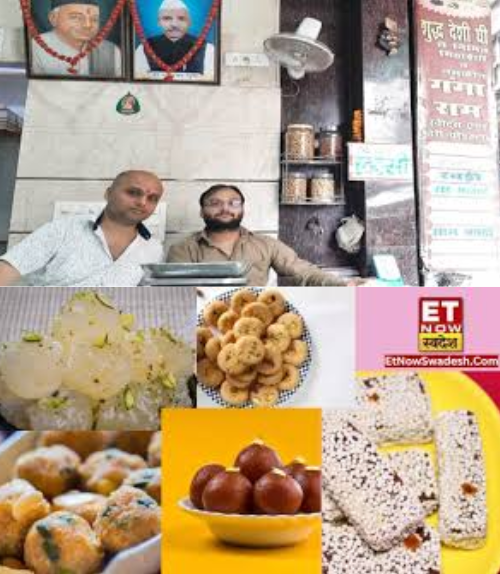Agra- Shopkeepers were surprised to see Lalpari and Balpari in sweets, crowd gathered
In Agra, a city steeped in heritage and tradition, the festive season is a time of joy, color, and sweet indulgences. Known for its exquisite sweets and vibrant markets, Agra transforms during festivals into a bustling hub of celebration. Yet, amidst the glimmering lights and sweet aroma of fresh desserts, a bizarre and unsettling tale has gripped the city. It’s the curious and troubling story of two mysterious women, ominously nicknamed “Laal Pari” (Red Fairy) and “Baal Pari” (Hair Fairy), whose disruptive antics have left the city’s sweet shop owners alarmed, frustrated, and fearful.
It all started subtly. A few shopkeepers began noticing unusual behavior from a female customer clad in bright red or yellow suits. She would enter their stores, demand to sample sweets, and once served, begin eating the delicacies with gusto. But what followed was shocking. Instead of purchasing the sweets, she would defile them—dropping them on the floor, smearing them, or contaminating them in a way that made them unsellable. Often, she targeted high-value items like rasmalai or fruit cream, sometimes even ruining two to four kilograms worth of sweets in a single visit. Then would come her dramatic proclamation: she had no money, her husband had run away, or she was a visitor stranded in the city. In several incidents, she reportedly claimed to be mentally disturbed, yet her legal knowledge and strategic behavior told a different story.
Local sweet shop owners, initially sympathetic, began to grow suspicious. One shopkeeper recalled how she confidently referenced legal protocols when confronted, even challenging the police by citing her rights and quoting laws. This composure, coupled with the pattern of behavior seen across multiple sweet shops—sometimes hitting up to eight or nine outlets in a single day—suggested a deeper, possibly organized motive. Videos of her actions began circulating among business communities, warning fellow shopkeepers of her presence.
Then came “Baal Pari,” a separate menace that relied not on physical presence but on the power of fear and deceit via telephone. Several sweet shops across Agra began receiving calls from a woman claiming that she had bought sweets from their shop. According to her, a strand of hair was found in the sweets, which caused her nine-year-old son to fall severely ill and be hospitalized. She used the same story repeatedly, often within the same two-hour window, targeting different sweet shops with the exact narrative. Some shopkeepers were demanded to pay between ₹9,000 to ₹13,000 as compensation. The emotional angle and urgency of a sick child made the calls difficult to dismiss immediately.

As the stories of these two “fairies” spread, shop owners began to collaborate and share details. When they matched phone numbers, behaviors, and timelines, the consistency was alarming. The same woman, the same phone number, and the same emotional manipulation pointed not to coincidence, but conspiracy.
In one particularly brazen incident, a woman reportedly packed two kilograms of sweets, then, claiming dissatisfaction, began eating from the box and discarding the rest on the floor. She later walked out without paying, all the while arguing with the staff and claiming victimhood. Another time, she used bottled drinking water not to drink, but to wash her hands and feet in the shop, defiling the space and causing further discomfort.
For business owners, this goes beyond mere nuisance. During the festive season, sweets are not just products—they represent livelihood, tradition, and trust. Each ruined box of sweets is a financial loss. But more importantly, the reputational damage, especially when circulated via social media or word of mouth, can be catastrophic. In India, food hygiene and quality are sacred to consumers, and one accusation—however false—can destroy years of brand building.
The psychological toll on shop owners is equally heavy. Several expressed feelings of helplessness and fear. They worry about false legal entanglements, customer backlash, or social media outrage if any video goes viral. Most have taken their grievances to the local police and food safety authorities. However, as of now, there is little clarity or action. Neither “Laal Pari” nor “Baal Pari” has been officially identified or apprehended.
What makes the situation more complex is the question of intent. Is this the work of mentally disturbed individuals exploiting their condition? Or is it a calculated attempt by an organized group aiming to extort money or sabotage specific businesses? Some shopkeepers believe this is an elaborate scam, possibly orchestrated to discredit or financially damage well-established sweet brands in the city.

In many cases, the disruptive woman speaks fluently and authoritatively. She appears to know her legal rights, talks down to police officers, and challenges shop staff confidently. In one audio recording, she is heard saying that the police “will touch my feet ten times” and mocking the idea that the court system could do anything to her. Such arrogance only strengthens the suspicion of deliberate fraud.
Shop owners have tried various measures. Some have posted pictures of the suspects on their shop walls or community groups to warn others. Others have taken the route of refusing service outright when they recognize the individual. In one case, a staff member politely asked the woman to leave after recognizing her from videos. She retaliated by attempting to contaminate sweets on the counter before leaving.
The story of “Baal Pari” is just as sinister. Using emotional blackmail and invoking the image of a sick child, the caller’s aim seems clearly financial. One owner said the woman called and cried over the phone, demanding compensation for medical expenses. When he suggested she visit the shop, the call abruptly ended. Cross-verification with other vendors confirmed a pattern—identical stories, same number, and no follow-up.
Even the police have not been immune to these tactics. Some officers, when called to deal with the suspects, found themselves being challenged or insulted. The accused women used legal jargon and a confident tone to deflect confrontation. Several officers have reported difficulty in addressing the situation without solid proof or physical evidence of fraud.
Meanwhile, sweet shop owners continue to suffer. For them, the festive season should be their most profitable and joyous time. Instead, it’s become a time of anxiety and second-guessing. They fear every new customer. They are wary of every phone call. Most of all, they worry about the damage to their brand and the loss of customer trust.
This bizarre saga of the “Red Fairy” and the “Hair Fairy” has become one of Agra’s strangest unsolved mysteries. It’s a tale that reflects not only on individual mischief but also on the vulnerability of small businesses to deception and manipulation in the digital age. As videos and messages continue to circulate, the community of sweet shop owners hopes for swift and decisive action.
Until then, they continue working—carefully, cautiously, and with hope that the spirit of the festival will triumph over the chaos these mysterious figures have brought. The city of love, known for its Taj and treats, deserves a season filled with sweetness, not scandal.
Play video :
News
Aslı Enver’in medeni durumu: “Özcan Deniz’le bu kez her şey resmileşecek”
Aslı Enver’in medeni durumu: “Özcan Deniz’le bu kez her şey resmileşecek” . . . Aslı Enver ve Özcan Deniz: Bu…
Özge Yağız ve Gökberk Demirci’nin En Romantik Günü Sosyal Medyada Kalpleri Eritti*
Özge Yağız ve Gökberk Demirci’nin En Romantik Günü Sosyal Medyada Kalpleri Eritti . . . Özge Yağız ve Gökberk Demirci’nin…
Cenk bir röportajında itiraf etti: “Mahassine’e çok aşığım ve yakında evleneceğiz”
Cenk bir röportajında itiraf etti: “Mahassine’e çok aşığım ve yakında evleneceğiz” . . . Cenk Torun’dan Büyük İtiraf: “Mahassine’e Çok…
Gökberk’in Cemre’ye şoke eden teklifi, erken evlilik mi?
Gökberk’in Cemre’ye şoke eden teklifi, erken evlilik mi? Gökberk’ten Cemre’ye Şoke Eden Evlilik Teklifi! Erken Nikah mı Geliyor? Türk Magazin…
Salman Khan, Arbaaz Khan With Pregnant Shura Khan At Arpita Khan’s Birthday Party
Salman Khan, Arbaaz Khan With Pregnant Shura Khan At Arpita Khan’s Birthday Party At a high-profile Bollywood event, the air…
It was Salman Khan and not Arbaaz Khan who fulfilled his duty as a husband to pregnant Shura. Arbaaz
It was Salman Khan and not Arbaaz Khan who fulfilled his duty as a husband to pregnant Shura. Arbaaz In…
End of content
No more pages to load







